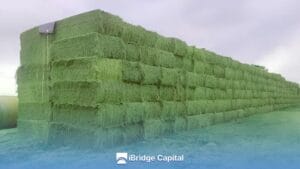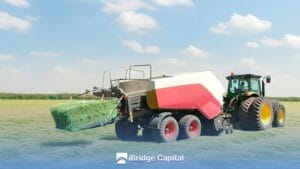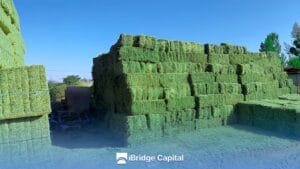The goal of every forage producer is to maximize their harvest. But when we talk about how many alfalfa mega-bales per hectare you should get, the answer goes beyond a simple number. It’s about understanding how science and field management come together to achieve production that is not only abundant but also of high quality.
If you’re wondering what the ideal alfalfa yield per hectare is, you’ve come to the right place. We’re going to explore the factors, calculations, and strategies that will lead you to optimize your field.
What is an ideal alfalfa yield per hectare
When producers ask how many alfalfa bales per hectare they should expect, they are really looking for a benchmark. The ideal production figure depends on the geographical area, the type of soil, and the management techniques you use. An outstanding yield in one region can be average in another. Alfalfa production per hectare is a crucial metric, as it directly impacts the profitability of your business.
The alfalfa yield per year is the sum of all the harvests you carry out in a season. A producer can get between 4 and 7 cuts, and each one contributes a part to the total. It is a common mistake to compare production without taking these factors into account. A good starting point is to know the average paddock yield in your area and seek to surpass it with improved management practices. The ultimate goal is to achieve the greatest number of alfalfa bales per hectare with the best possible quality.
Understanding alfalfa production in tons
Before converting production to bales, it is first measured in tons of dry matter per hectare. Alfalfa production is a measure of the total amount of forage your crop generates. A producer with optimal management in an irrigated field can expect an alfalfa yield of between 18 and 25 tons of dry matter per hectare per year. However, a more conservative but solid yield is in the range of 12 to 16 tons of alfalfa per hectare.
These figures for kilos of alfalfa per hectare are the starting point for any calculation. Knowing how many kilos of alfalfa per hectare you produce annually is the first step to determining how many bales you can pack. This measure also helps you understand your soil fertility and the efficiency of your irrigation system, allowing you to adjust your strategies for the future.
Differences between dryland and irrigated yields
Water is, without a doubt, the most determining factor in alfalfa production. Therefore, dryland alfalfa yield is drastically different from that of an irrigated crop. While multiple cuts and high yields can be achieved in an irrigated system, irrigated alfalfa yield in non-irrigated areas can be much lower, often limited to one or two cuts in the rainy season.
For example, alfalfa yield per hectare in dryland planting could be only 4 to 8 tons per year, which translates into a very different number of bales. The producer’s objective, in this case, is to maximize production under these conditions, looking for more drought-resistant varieties and doing fertilizer management in alfalfa that helps the plant withstand water stress.
Key factors that influence alfalfa yield
Achieving a high yield is both an art and a science. To know how to measure alfalfa yield per hectare effectively, you must consider all the elements that interact in your field, the final result does not depend on luck, but on a series of well-thought-out agronomic decisions, the alfalfa yield per hectare in ideal conditions is only achieved when most of these variables are controlled.
The impact of soil and climate on your crop
The soil is the foundation of everything. Deep, fertile soil with good drainage is ideal for alfalfa, whose roots can reach considerable depths in search of water and nutrients. Soil fertility, pH, and texture directly impact plant growth. On the other hand, the climate, hours of sunshine, and optimal temperatures are essential for optimal plant development.
The alfalfa yield per hectare is also affected by extreme weather conditions. Late frosts, hail, or excessive heat can reduce production. A soil analysis for alfalfa is the only way to know with certainty the conditions of your field and apply the necessary alfalfa fertilization. With this data, you will know if your soil can support high production.
Agronomic management to maximize production
Hay production per hectare depends to a large extent on how you manage your crop. The timing of planting, plant density, weed and pest control, and irrigation management are all decisions that directly impact the final result. A good fertilization plan for alfalfa is also a pillar of high yield.
In grazing systems, forage yield per hectare can be more difficult to quantify, but good rotational management ensures plant health and allows for quick recovery. If you are dedicated to hay production, the time of cutting is one of the most important decisions you will make to maximize mega-bale yield per hectare without sacrificing quality.
The calculation of alfalfa bales per hectare
Now that we understand that yield is measured in tons, we can answer the question of how many alfalfa bales per hectare you could get. The conversion from tons to bales is a simple calculation, but it requires knowing two key pieces of data: your total yield and the average weight of the bale you produce.
Weights and measures: the key mega-bale factor
The machinery you use impacts the weight of each unit. To know how much a mega-bale weighs, you must take into account that these large rectangular bales have an average weight ranging from 450 to 650 kg, depending on density and moisture. For export hay, an ideal weight is in the range of 500 to 550 kg. If you’re wondering how much does an alfalfa bale weigh, it’s much smaller, generally between 15 and 25 kg.
The weight of an alfalfa mega-bale is an important measure for logistics and transport. If your goal is export, you should standardize this weight as much as possible to facilitate container loading. To know how many grass bales per hectare or alfalfa bales you can get, it is always best to work with an average weight.
How to calculate bale production per hectare
To do the bales per hectare calculation, let’s follow an example. If your field has an alfalfa yield per hectare of 15 tons of dry matter per year, and your average mega-bale weighs 500 kg, the calculation would be as follows:
Total yield in kg: $$15,000 \Average mega-bale weight:
500 kg
15,000/500=30 mega-bales per hectare
Thus, we can see that good production translates into a good number of mega-bales per hectare. The same calculation applies if you’re wondering how many alfalfa rolls per hectare or how many hay rolls per hectare you’ll get, you would just have to use the average weight of a roll. This way, the alfalfa production calculation in mega-bales becomes simple and practical.
Alfalfa yield per cut and per year
The alfalfa yield per hectare is the sum of all the cuts made during the season. It is a mistake to expect the same production from each cut, as yield changes throughout the year. Understanding this dynamic is crucial for planning your harvest and sales.
Estimating the production of each cut
The first cut, or spring cut, is usually the largest in volume. Then, alfalfa production per hectare stabilizes in the summer cuts and can be reduced in the last autumn cuts. If you’re wondering how many alfalfa bales per cut you will get, you should note that the first cut can yield 4 to 6 tons per hectare, while the following ones can be in the range of 2 to 4.
The question how much does a hectare of alfalfa yield is best answered when you take these variations into account. The forage yield per hectare in the first cut is a good indicator of the health of the crop. A producer knows that the second and third cuts are the most important for hay quality.
How annual yield is distributed
A good alfalfa yield per year could be 18 tons per hectare. If you make 6 cuts, the yield of each cut will not be an equal division of 3 tons. Rather, alfalfa bale production per hectare could be as follows:
- Cut 1: 30% of the annual yield.
- Cut 2: 25% of the annual yield.
- Cut 3: 20% of the annual yield.
- Cuts 4, 5, and 6: The remaining 25%.
This is a more realistic way of looking at how much does 1 hectare of alfalfa yield in a year. This view allows you to plan your sales and know when to expect production peaks.
Strategies to increase your field’s production
The ultimate goal is always to maximize alfalfa yields. It is not about luck, but about a well-defined strategy that covers everything from soil preparation to harvest. If you’re wondering how to increase alfalfa bale yield, the answer lies in the combination of several factors.
Fertilization: the pillar of a high yield
Correct fertilization is the basis of a high alfalfa yield per hectare. Alfalfa, although it fixes nitrogen, extracts large amounts of phosphorus and potassium from the soil. An adequate fertilization plan for alfalfa, based on soil analysis, ensures that the plant has all the nutrients it needs to grow.
Alfalfa fertilization must be a continuous practice, especially if the crop is perennial. The application of phosphorus and potassium after each cut, or an annual maintenance application, is crucial for sustaining productivity.
Variety selection and planting density
The choice of variety is one of the most important decisions. There are varieties designed to produce more forage, with greater resistance to pests and diseases. An adequate variety can make a notable difference in your alfalfa production per hectare.
Planting density is also a key factor. A planting that is too dense can lead to competition for nutrients and sunlight, while a sparse planting leaves space for weeds. The ideal density varies, but it is generally between 20 and 30 kg of seed per hectare.
Alfalfa quality: the export factor
For the producer who is targeting the international market, the question is not just how much does a hectare of alfalfa yield, but how much does 1 ha of alfalfa yield of high quality. The export market is very demanding, and profitability is measured by the quality of the hay, not just the quantity.
Alfalfa requirements for the international market
The export market looks for hay that meets the highest standards. Good export hay must have a high protein content, low fiber, and good digestibility. Dryland alfalfa production hardly reaches these levels of quality, which are more common in irrigated alfalfa yield.
The hay yield per hectare becomes secondary when the quality is deficient. Low-quality hay, even if it is abundant, will have a much lower market value. Therefore, the focus must be on producing high-quality alfalfa mega-bales per hectare.
How cutting influences hay quality
The timing of the cut is the most important factor for quality. Export alfalfa is cut at the pre-bud or bud stage, before the plant flowers. At this stage, the protein content is higher and the fiber is lower. A late cut increases the yield in kilos but drastically reduces the quality.
That’s why constant monitoring of your crop is so important. If you’re wondering how many alfalfa bales per cut you should expect, the answer is that you’re not just looking for a high number, but the optimal moment to get the best quality. The alfalfa yield per cut may be lower, but the value of the final product will be higher.
Common problems that reduce your yield
Sometimes, grass production per hectare is not what you expect. Many problems can considerably reduce forage yield, and most of them can be prevented with good management. Identifying and correcting these problems is key to the health of your field and your business.
The importance of a good soil analysis
A soil analysis for alfalfa is your best ally. A soil with a phosphorus deficiency, for example, can seriously limit root development and, therefore, yield. Similarly, a soil with an incorrect pH can prevent alfalfa from absorbing nutrients, even if they are present. Deficiency symptoms in alfalfa can be the first sign that something is wrong in the soil.
Soil fertilization for alfalfa is the solution to these problems. By applying the correct fertilizer, you can correct imbalances and give your crop the best opportunity to reach its maximum potential.
Diseases and pests that affect production
Pests like aphids and diseases like rust can drastically reduce alfalfa yield per hectare. Prevention, through the choice of resistant varieties and constant monitoring, is the best strategy. Integrated pest management, combined with a healthy crop, is the best defense.
If you’re wondering how much does a hectare of hay yield when your crop is sick, the answer is that the yield will drop, and the quality of the forage will too. That’s why good crop management is just as important as fertilization.
Conclusion
The question of how many alfalfa mega-bales per hectare does not have a single answer. The number is the result of smart management, understanding the alfalfa requirements, and making agronomic decisions based on data.
Success is measured in a solid yield, but also in the quality of the forage you produce. We encourage you to take control of these factors in your field, implementing a fertilization plan, choosing the best varieties, and constantly monitoring your crop. By doing so, you will not only increase your mega-bale production but also position yourself to obtain a greater value in the market.




